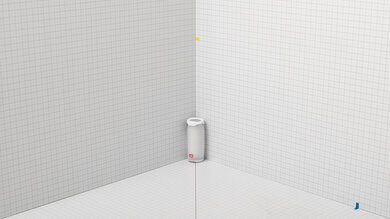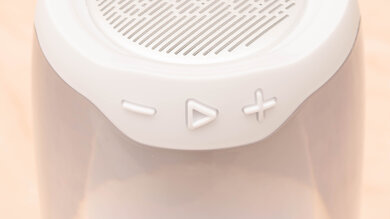The JBL Pulse 4 is a portable Bluetooth speaker with eye-catching RGB lights wrapped around the device. You can customize different colors and patterns in its companion app to set the mood as you listen to your favorite tunes. It's small and lightweight, and its IPX7 rating for water resistance is handy if you plan to bring it outside. That said, it doesn't offer as many features as the next-gen JBL Pulse 5.
Our Verdict
The JBL Pulse 4 has an acceptable performance for music. With its balanced mid-range, this speaker reproduces voices and lead instruments with clarity and accuracy. That said, it lacks low bass, even compared to other smaller speakers, so you miss out on the thump and rumble in bass-heavy genres. There aren't any customization tools on hand for its sound, either.
- 11.5 hour battery life.
- Supports multi-device pairing.
- Lacks low bass.
- No sound customization tools.
This speaker isn't really meant for watching movies. Still, you can use it to check out videos on a paired smartphone. Dialogue is pretty clearly reproduced, though you don't get a cinematic rumble in the bass range. Plus, it's not really loud enough to fill bigger rooms with sound.
- Supports multi-device pairing.
- Lacks low bass.
- No sound customization tools.
The JBL Pulse 4 is good for podcasts. Thanks to its balanced mids, dialogue is pretty clearly and accurately reproduced, making it easy to follow along with your favorite shows. You can bring it from room to room for longer episodes, thanks to its portable design. That said, its sound profile doesn't have any customization features.
- 11.5 hour battery life.
- Supports multi-device pairing.
- No sound customization tools.
This speaker doesn't support voice assistants.
The JBL Pulse 4 is satisfactory for outdoor use. This small, lightweight speaker is easy to bring around wherever you go, and its over 11-hour battery life keeps the party going well into the night. Plus, it's rated IPX7 for water resistance, so it's protected a bit against the elements. That said, it doesn't get loud enough to fill larger, more open spaces like a backyard with sound.
- IPX7 rating for water resistance.
- 11.5 hour battery life.
- Lacks low bass.
- No sound customization tools.
Changelog
- Updated Sep 04, 2024: We've updated the Battery scores and text, as we've reevaluated how the Battery Life, Charge Time, and Power Saving scores are weighted. We've also updated the relevant usage boxes that were affected by this recalculation.
- Updated Feb 16, 2024: Updated review text for consistency. No changes in test results.
- Updated Mar 08, 2023: Added market comparison with the JBL Pulse 5 to the App box.
- Updated Dec 19, 2022: Changed Track Next/Previous from No to Forward Only (Physical).
Check Price
Differences Between Sizes And Variants
The JBL Pulse 4 comes in two color variants: 'Black' and 'White.' Both variants have 360-degree RGB lights surrounded by a transparent plastic cover. We tested the 'White' variant; you can see the label for the model we tested here. We expect both variants listed to perform similarly in tests.
If you encounter a variant not mentioned here, let us know in the comments so we can update our review.
Popular Speaker Comparisons
The JBL Pulse 4 is a portable Bluetooth speaker that stands out thanks to its "pulsing" RGB lights, which you can customize to suit your mood. It has a similar design to the next generation JBL Pulse 5, though it doesn't have as many features, like a graphic EQ for sound customization. It also lacks a lot of low bass, even compared with other portable speakers.
See also our recommendations for the best Bluetooth speakers, the best waterproof Bluetooth speakers, and the best JBL speakers.
The JBL Pulse 5 is the next generation of the JBL Pulse 4 and is the better speaker overall. While both speakers have similar designs with built-in RGB lights, the Pulse 5 has some extra features, such as ambient noise settings and a graphic EQ in the app. It's also able to reproduce a bit more low-bass than the 4. However, the 5 doesn't have play/pause or volume controls on the device like the 4, so you have to control those settings through the app, which isn't always ideal.
The JBL Charge 5 is a slightly better speaker than the JBL Pulse 4. The Charge 5 is better built and has an IP67 rating for dust and water resistance, certifying it to be dust-tight and immersible in up to a meter of water for 30 minutes. It can also get louder and offers a better-balanced sound profile that can produce deeper bass than the Pulse 4. However, the Pulse 4 comes with customizable RGB lights and offers a more natural-sounding soundstage thanks to its 360-degree design.
The JBL Pulse 4 is a better speaker than the JBL Charge 4. While the Charge can reproduce a more extended low-bass, the Pulse has a more balanced sound profile, and its soundstage is perceived as more open. It also has customizable RGB lights and a unique transparent design. That said, the Charge has a slightly longer battery life, as well as less latency over Bluetooth, although some apps compensate differently for this.
The JBL Flip 5 and the JBL Pulse 4 are similarly performing speakers with slightly different features. The Pulse has fewer compression artifacts present at max volume, and it comes with customizable RGB lights. Its soundstage is also perceived as more open, and its battery lasts longer. However, the FLIP has a better build quality and is more portable, thanks to its removable carrying strap that lets you easily bring it with you on the go.
Test Results

The JBL Pulse 4 has a decent build quality. The speaker is wrapped in transparent, glass-like plastic, which feels solid. However, it easily attracts fingerprints, so you may need to clean it regularly. It sits on three plastic feet that raise it above the surface it's on. It's also rated IPX7 for water resistance, so you can submerge it in up to a meter of water for up to thirty minutes without issue.
The controls are located at the top of the speaker, and they're all easy to press. There are buttons for adjusting the volume and a play/pause button that you can press twice to skip a track. However, there's no option for going to a previous track. There's also a 'PartyBoost' button, which allows you to link multiple 'PartyBoost' compatible speakers. The power, Bluetooth pairing, and 'PartyBoost' buttons all light up when in use. The speaker's 360-degree RGB lights can be adjusted using the 'Light' button, and you can shake the speaker to sync the lights with other connected 'PartyBoost' speakers. There's also a light on the back that indicates the battery level. Although the speaker beeps when it reaches max volume, there's no sound to indicate when it reaches minimum volume.
This smaller speaker struggles to reproduce a deep and rumbling low bass, which is most noticeable with genres like EDM and hip-hop. Still, its mids are quite balanced, meaning voices and other lead instruments are clear and present in the mix. Unfortunately, there aren't any customization tools on hand for its sound.
This speaker's 360-degree design lends itself to excellent directivity, meaning you get consistent sound from all angles around the device. That said, it has to downmix stereo content into mono to play it back, so you don't get a clear separation between the right and left channels with stereo tracks.
This speaker gets loud enough to fill an average-sized living room with sound, and there isn't too much compression when you push it to max volume. That said, it's not really meant for larger or more open spaces.
The manufacturer advertises this speaker to last 12 hours off a single charge, which is pretty consistent with our test results. There's even a power-saving feature to shut the speaker off after twenty minutes without an audio file, which helps conserve battery life. That said, charging back up takes quite a while, which isn't ideal for everyone.
The JBL Portable app is okay. It's compatible with iOS and Android, and you can use it to make patterns for the speaker's RGB lights. You can pair two speakers to create a stereo pair or link them with the 'Party Mode' feature to amplify audio for a larger space. The 'Equalizer' feature makes a light pattern, but the app doesn't include sound adjustments like an EQ. If you want a similar speaker that's more customizable, check out the next-generation JBL Pulse 5.
You can't use this speaker wired. It comes with a USB-C to USB-A cable for charging.
Wirelessly connecting this speaker to your mobile devices via Bluetooth is easy. You can even pair it up to two devices at the same time. Overall, AV sync error falls within pretty good limits, especially with Android devices, so you don't notice much delay between the audio you hear and the visuals on screen. It's worth noting that some apps compensate for this differently, though.







